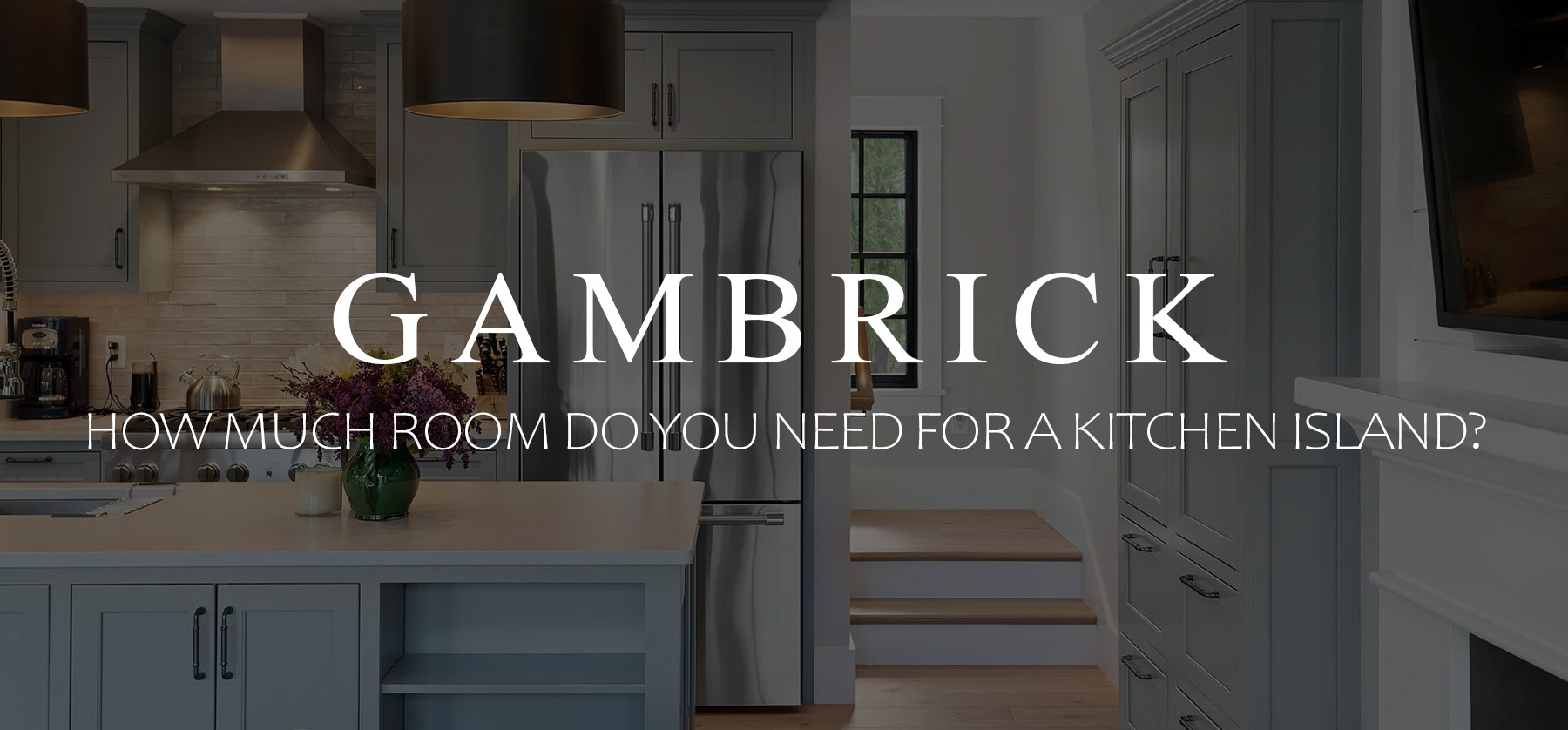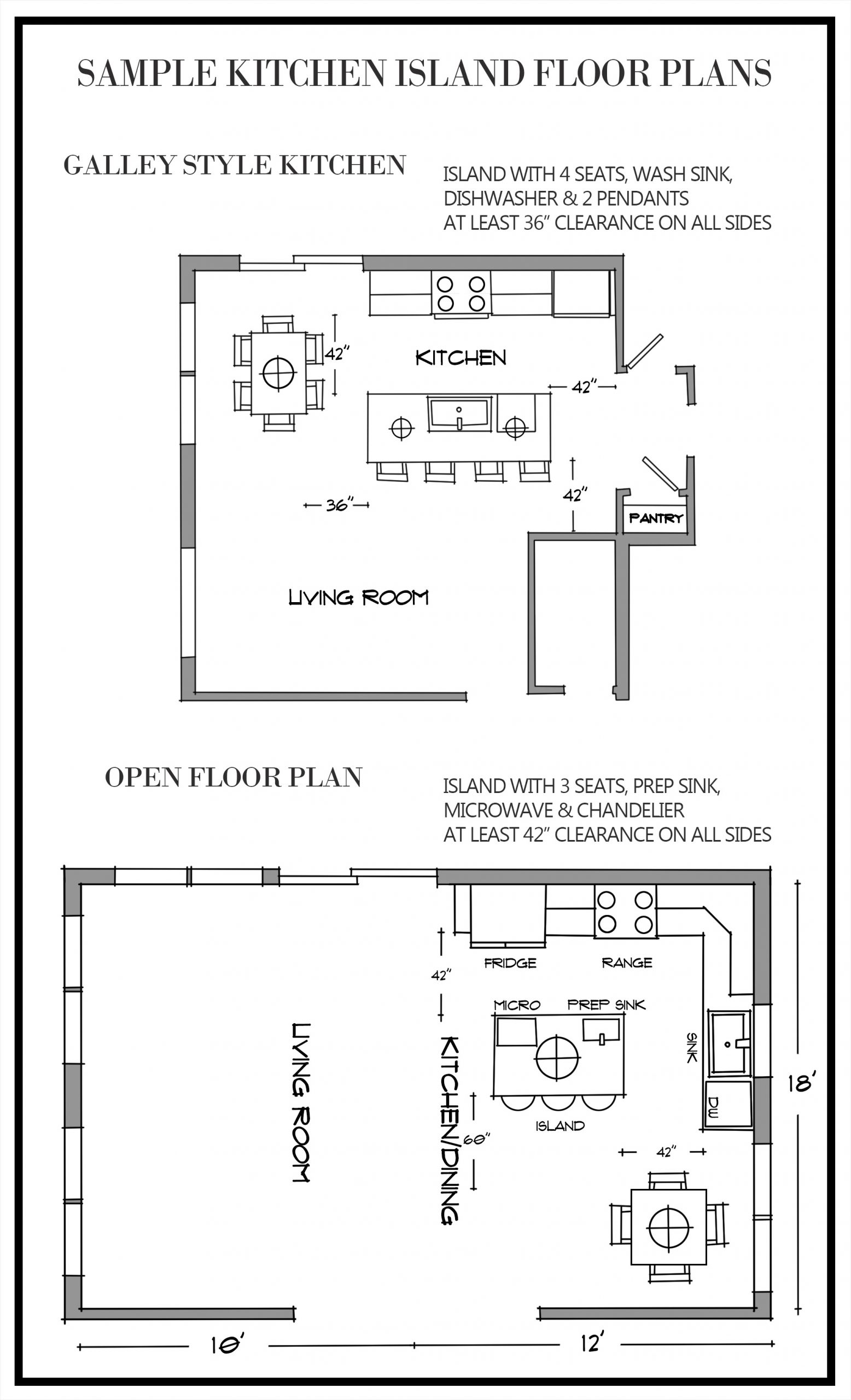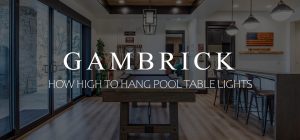How Much Room Do You Need For A Kitchen Island?
Adding an island to your kitchen layout ups your style points tremendously and it’s a great way to increase both counter and storage space. Considering all three are very in demand when it comes to kitchens, islands are seen as a must have. Especially in luxury kitchens that can easily cost over 100k to build. But an island isn’t just for the rich or people with huge kitchens. I’ve built some truly fantastic small kitchens with centered islands that were both functional and beautiful. The minimum amount of room you need for a kitchen island is about 10′ x 9′ of open space. This accommodates a small 40″ x 30″ island with 2 stools and either 2 pendants or a chandelier.
The minimum amount of space you need around an island is approximately 36″ on all sides. This is not only for walking but also to sit on stools, open drawers and use appliances. 40″ to 42″ is better behind the stove and other appliances if you have the room, but if space is tight 36″ will do. The smallest island I’d use is 40″ wide x 30″ deep. That’s just to 20″ wide x 28″ deep cabinets which barely fits two stools. But it works in tight spaces.
Kitchen island mistakes are very common. A well planned layout provides a smooth workflow and a comfortable space for preparing and cooking food. Islands also provide space for eating, working, relaxing and storage. But while a well designed layout makes a kitchen flow better, a poorly planned island can be frustrating. This is especially true if the island is too big for the space. If you’re considering adding an island, the following tips will help you layout your kitchen like a Pro.
Islands Are Sized For The Kitchen They’re In
Don’t assume that you can’t have an island just because your kitchen is small. An island should always be sized according to the free space inside the kitchen after the wall cabinets are installed. You don’t size an island based on the total dimensions of the room because wall cabinets take up floor space. Once the base cabinets and dining table are in, measure the amount of free space you have left for an island.
A kitchen island needs at least 3 feet on all sides to walk around, sit on stools, use drawers, doors and appliances. But between 42 to 48 inches is best.
- Install all your base cabinets.
- Position your dining table and chairs.
- Measure the amount of free space from the edge of the island to the walls, other cabinets or table’s edge. Do not measure to the table’s chairs.
- Subtract 6′ from the width and length of the measurements you took.
- If you have at least 40″ x 30″ left over you’ve got enough room for a small island.
An island can work even where space is limited. In fact, because cabinet space is limited in a small kitchen, islands can be a big help. They’re harder to squeeze into small spaces, but I’d argue you have more to gain from one than in a large kitchen.
If your kitchen is less than 13 feet wide I don’t recommend installing an island. A peninsula style cabinet tends to work better. Or you could use an island on wheels, called a kitchen cart, which can be pushed out of the way when not in use.
It’s easy to fit an island into a large kitchen. In fact they’re pretty much a standard feature. Most include appliances and a sink plus storage and seating space.
How Big Should A Kitchen Island Be?
The size an island should be is relative to the kitchen it’s in. Of course you can have a much bigger island in a larger kitchen. Proportions and minimum distances between the island and appliances, walls, tables, etc. all matter. Always keep in mind that a kitchen is a workspace first and foremost.
In super small kitchens, I like adding more work surface and storage. Not all islands need to have seating. An island can be something as small as 2’ square with a drawer, cabinet and places on the sides for hanging things and paper towels. A center island that’s more utilitarian can be a huge help in a tight kitchen.
Larger kitchens are lucky because they have so much space, but it can be a hindrance too. Large islands can get in the way and make work flow difficult if you overdo it. I like my islands in larger kitchens to be at least 3’ wide and 4’ long. This is enough for 3-4 nice chairs, 2-4 pendants, appliances, work space, a sink or a chandelier. Ideally you’ll want storage and appliances on one side and seating on the other. Try for 12” to 15” of knee space between the top of the stool and the bottom of the countertop.
If you’re building an island out of stock cabinet boxes, you’ll probably have to adjust the size of the island to suite. However if you’re building with custom cabinets you can make it whatever size you want. Generally I use stock cabinets. There are enough sizes that I can almost always make it work.
Minimum Dimensions for a Kitchen Island
You can get away with smaller distances between a kitchen island and other counters, walls and tables than you sometimes see recommended. In general, 36 inches is the minimum recommend clearance from the edge of the island to other things. But I’ve gone as low as 30″ in some cases. Depending on how you use your kitchen, you can go tighter in places. How many people are in the kitchen at a time matters too.
- A 30″ x 40″ is on the small side for what we typically build.
- The most common island size is 36″ x 48″.
- I’ve built utilitarian island as small as 24″ x 24″ with great results.
- On the large side, I wouldn’t go longer than 12′. Even in huge kitchens you need to break up the design a bit. If you have a ton of space try multiple islands instead of one huge one.
- 4′ x 8′ is a great size. You get plenty of counter space, seating, appliances, a sink, lighting, etc. Just about everything you could want from an island fits in this size.
- I wouldn’t go much wider than 6′.
You have a lot of flexibility when it comes to island size. When your designing a kitchen, keep clearances in mind along with the overall proportions of the room, work flow and make a list of what you want from the island. Do you want a sink? Appliances? Seating? Try to fit everything you want within the space you have. Once you achieve everything on your list the island is big enough. A lot of designers overdo the island and it ends up overpowering the room.
Kitchen Work Space
Even though 36 inches is the minimum amount of space you need around an island, 40″ to 42″is much better. Especially where you’ll be working. Whenever possible, I leave 36 inches for walkways and 42 to 48 inches in work areas. Of course this requires a pretty big kitchen. When I have to choose between a bigger island or more room around the island, I usually opt for more room. It makes the kitchen flow better and a huge island can sometimes feel too big for a room.
The National Kitchen and Bath Association recommends 42 to 48 inches for work space. This is areas around the stove, appliances and where you’ll be preparing food.
36 Inches for walkways is also enough room for drawers on opposing sides to be open at the same time without touching. Although it’s doubtful you’ll ever do that.
Rugs are another consideration. More and more people are using long thin area rugs in the kitchen walkways. If you plan on using one, take the rugs dimensions into consideration when laying out the kitchen. Most rugs are 30″ to 36″ wide which would work in a 36″ to 48 inch walkway.
Consider how many people will be using the kitchen at once. If it’s just you you’ll need a lot less room than a large family. Many people use their kitchen as a central hub for the home. While you cook kids may hang out or do homework. At parties people may walk behind each other while sitting at the island or cooking. The more room the better if you have the space.
I generally prefer scaling down an island a little bit in a large kitchen rather than maxing out the space with something huge.
Should A Cook-Top Or Sink Go On A Kitchen Island?
Personally I love when the island has a sink. Especially when the island looks out into the living room or a great view. I generally like to point the sink at something. Whether it be a window or just the rest of the house. These days most new homes have an open floor plan, if your island overlooks the living room or a fireplace I’d point the sink at it.
Prep sinks are another consideration. If your main sink is on the wall cabinets, you may want to include a small prep sink somewhere else. If you prepare food on the island they make sense for washing vegetables, meat or fruit near where your working. There also great for hand washing while someone else is at the sink. I like having two sinks if I can fit them in, and the island is usually the right spot for it.
Cook-Tops are another favorite of mine. They make cooking in a group more fun because everyone can be around the stove as you cook. I watch a lot of Gordan Ramsey cooking videos and you can always see over the stove at him while he cooks. This is because his stove is on an island cook-top. You also get to look out at the house as you cook. But you’ll have to put a lot of thought into the range hood. I like the space above the cook-top to be left open so you can see around which means the hood has to be really high and strong.
Island drafts can work, but they’re not meant for serious cooking. I prefer using a commercial grade hood that’s set higher up so I can see everything around me while still getting ventilation.
Room You Need For An Island In A Really Small Kitchen
The minimum recommended size of a fixed kitchen island is about 40 by 30 inches with about 3 feet on all sides to walk. Although small, these dimensions allow for a working island with optional appliances and two stools. But what if you don’t have that much space.
I’ve had some success recently by pushing the island closer to the wall on the side with the stools. It’s tight, but 30 to 32 inches between the wall and island is enough to sit. It’s not generally enough to walk around the island while someone is sitting, but since the island backs up to a wall it works out and is actually comfortable to sit in. I like using this wall as a gallery to showcase photos or artwork. Shelves or cabinetry are out because the space is too tight but there’s more than enough room for frames. And who doesn’t like a good gallery wall.
Clearance space of this size is OK for one or two people working in the kitchen and two more sitting. Any more than that feels a little cramped but I’m used to living in apartments and know you can make it work. Some of the best kitchens I’ve designed and built have been really tiny. It’s a challenge but the end result can be worth the effort.
Proportions Are Important In A Well Designed Kitchen
The average size of a kitchen island is about 3′ deep by 6′ long with at least 36″ around all sides. The island seats 3 stools and is big enough for a sink and an under cabinet appliance. The cabinets that make up the island are around 30″ deep which allows for a 5″ to 6″ overhang for the stools. Above the island is enough space for 2 to 3 pendants or a center chandelier. This setup fits the average 16′ x 12′ kitchen nicely with proportions that are just right.
An island’s size is usually determined by the amount of free space you’ve got inside the room after the base cabinets are in place. So it makes sense that larger rooms allow for bigger islands. But something too large can overpower the room and ruin your kitchen’s aesthetic. Every kitchen needs a sense of balance and proportion.
- If your designing for a large kitchen, resist the urge to go too big with the island just because you have the space. Keep at least 42″ to 48″ between the island and other countertops.
- If your designing for a small kitchen, resist the urge to go too big here as well. The kitchen should be functional which means enough space to cook and eat.
If an island’s dimensions are not proportional to its surrounding space, you risk creating a cramped room with an inefficient work-flow. Remember that the primary function of a kitchen is to cook food. Not just to look good. Proper kitchen design means putting function first.
Walking around an island can be hard if it’s too big. Keep in mind the location of important appliances like the sink, stove and fridge. This is often called the kitchen triangle. An island shouldn’t get in the way of your work-flow.
Galley Kitchen Layout Allows For A Larger Island
Most chefs prefer a galley kitchen layout which features two parallel runs of cabinet. Have you ever watched any cooking shows like Chopped. It’s one of my favorites and features a galley style kitchen. Chefs prepare the food on the island and cook on the stove behind them. It’s a great layout for cooking because everything is in easy reach without having to turn any corners. And it allows for a larger island. This is a design you may be able to use in your home too.
A galley island layout allows you to stand at the island with all your appliances right behind you. In a well thought out design design, this allows safe and easy access to all work surfaces, cabinets and appliances during cooking.Most commercial kitchen are designed this way.
When designing a galley kitchen, keep the distance between the island and countertop between 36″ to 48″. Any more space and you’d have to walk between countertops. The idea is that everything should be in reach with just a spin. The only walking you’ll need to do is side to side long ways along the counter.
Since all the cabinets are either in the island or on the wall, they tend to be longer with bigger islands. If you’re a fan of large islands and serious cooking, this design may be perfect for you.
Consider Countertop Size
In addition to figuring out how much room you need for a kitchen island, you should also consider the countertop size. Almost all countertop materials have a maximum size limit before requiring a seam. Stone slabs only come so big and maneuvering them into the house and onto your cabinets is another issue. I always try to avoid countertop seams whenever possible. Even when they’re installed perfectly you can still see the line.
Also check to make sure the countertop will fit inside the house. Island cabinets are easy because you install them one at a time. But large countertop slabs come in one big piece so maneuvering can be a challenge. I’ve installed plenty of long slabs that required taking out a window to get them in the house. It’s not always easy if you have a narrow flight of stairs or some winding hallways.
Weight is another consideration. Large stone slabs can weigh around 1000 pounds. That requires at least 4 to 6 people to put them in place. The cabinets and floors have to be strong enough to hold that amount of weight in one place plus the cabinets, flooring, appliances and people. In new houses it’s probably not a problem, but a huge slab in an old house could cause sagging.
I recommend shrinking the island down as much as you need to in order to go seamless. It’s a much nicer, cleaner look.
Things To Consider When Designing A Kitchen Island
There are more questions you’ll need to answer when designing a kitchen island than how big it should be. I’ll be writing an entire article on how to design an island soon but for now here’s a small summary of things you should consider.
- How much storage do you need and what type? Drawers, cabinets or both? Inside the cabinets do you want them open for large things or with shelves? Do you want the shelves to pull out like drawers?
- Do you want electrical outlets? If so what type and where will they be? I recommend some outlets with USB connections. Most of my clients tend to charge phones on the island when they cook or eat dinner.
- Should the trash or recycling go in the island in a pull-out cabinet?
- Is the island the same color as the other cabinets? What about the countertops?
- How many seats do you need and what type?
- Consider lighting. Do you want a chandelier or pendants over the island. And if so how many?
- Do you want a sink, stove or dishwasher in the island. Plan ahead for this because it means plumbing.
The answers to many of these questions have a lot to do with how you’ll be using the island. Having a well designed island is a fantastic way to make the kitchen look and work much better. If you design it correctly.
Island Alternatives For Small Kitchens
If you don’t have enough space for a traditional kitchen island, there are some alternatives that may still work.
The most extreme option is remodeling the room to open it up and create more space. This is one of the main reasons open floor plans have become so popular in smaller homes and apartments. When the kitchen flows into other rooms without walls in the way, there’s usually enough space for an island or peninsula. This may mean taking down a wall that could be load bearing. I’d recommend consulting an architect or builder before doing any kitchen remodeling but this could be an answer for some and it may not be as expensive as you think.
A major remodel may not be an option for everyone but there are alternatives that work great. My favorite is a rolling island called a kitchen cart. They look great and are extremely functional. They’re built on wheels so you can move them out of the way when not in use. Or leave them in the middle of the kitchen and push them around when you need more room. Most offer extra storage space, more countertop, a rod for paper towels and many other options like seating. They also cost much less than a fixed kitchen island.
Kitchen Peninsula
If you don’t have enough room for a kitchen island, consider installing a peninsula instead. They share most of the great qualities an island provides but they’re connected to the wall cabinetry at one end. This means they can work in small spaces where an island can’t fit. Peninsulas are a fantastic choice for small kitchens because with one end fixed to a wall, they take up less floor space.
A peninsula doesn’t require the same clearance as an island because one side is fixed to the wall. This means you only need a minimum of 3 feet on three sides instead of four. Because of this, they work great in long but narrow kitchens.
A kitchen peninsula can have all the amenities you want from an island like seating, a sink, under cabinet appliances and great looks. But it’s connected to the cabinetry which means the style and color should match along with a matching countertop.
How Much Space Should Be Between An island And A Wall?
The absolute minimum amount of space you should leave between the edge of the island and a wall is 30 to 32 inches. Whenever I design a small kitchen I put the island seating in this area. It’s enough space to sit but not enough for a walkway when people are seated. Turn the space into a gallery wall or hang some artwork.
In a larger kitchen I always leave 36″ to 48″between the island and wall. This provides enough space for a walkway even when people are seated at the island.
How Much Space Is Needed Between The Kitchen Island And Cabinets Counter?
I recommend a minimum of 36 inches between the island and cabinet counter. But the ideal range is 40″ to 48″of space. This is especially important for the space around work areas like a fridge, sink, dishwasher or stove.
More than 48 inches is too much room. You should be able to reach the opposite counter by spinning around and not walking. Less than 36 inches is too little. The kitchen will be cramped and uncomfortable to work in. It could also create tripping hazards. When the oven door is open burns may be more common because you may not have enough room to work.
What Is A Good Size Kitchen Island?
A good size for a kitchen island is 4 feet long and 30 inches deep with around 3 feet on all sides to walk, open doors and drawers and sit. This size island provides enough room for 2 seats, plenty of countertop work space, a sink, and an under cabinet appliance. Above you’ll be able to fit 2 medium size pendant lights, 3 small pendant lights, or a chandelier.
Unless your kitchen is at least 8 feet wide by 12 feet long, it’ll be harder to have an island, but definitely not impossible. Some of the nicest kitchen I’ve designed and built were on the small size. With a little effort you can make it work.
What’s The Minimum Distance Between A Refrigerator And Island?
The minimum distance you should leave between an island and refrigerator is 36 inches. But that’s a little on the small size. The ideal range is 40″ to 48″. This provides enough room to open a single wide door and still stand in front of the island. If you have a side by side style fridge it doesn’t take as much room to open.
Kitchen Island Gallery
Below are a few of my favorite island kitchens. Each has a beautiful and well though out design that not only looks great, but makes the kitchen work-flow better. Use them as inspiration when designing your own kitchen island.
Beautiful galley style kitchen island with light blue-gray cabinetry.
Long kitchen island features storage and not seating.
The end of this long kitchen island has a built in seating area. This design keeps the island slim. It works great in a galley style kitchen.
Two tone kitchen cabinets. Blue island with white wall cabinetry.
Blue kitchen island with wood countertops along side white wall cabinets and black granite.
Two tone kitchen cabinets. Blue island with white wall cabinets. Modern style.
Lower kitchen prep island with sink. Wood countertops.
Stunning kitchen design including a blue island, marble countertops, white wall cabinetry and gold and wooden stools.
Marble island countertop with three gold pendants.
Beautiful all white kitchen with large island. Quartz countertops. Marble backsplash.
White countertops with blue kitchen island. White Quartz countertops. White backsplash.
White wall cabinets with a blue-gray island. Built in stainless steel appliances.
Beautiful Modern kitchen with a wood center island. White flat faced wall cabinetry. White quartz countertops.
Summary: How Much Space Do You Need For A kitchen Island?
Adding an island to your kitchen layout ups your style points tremendously and it’s a great way to increase both counter and storage space. Considering all three are very in demand when it comes to kitchens, islands are seen as a must have. Especially in luxury kitchens that can easily cost over 100k to build. But an island isn’t just for the rich or people with huge kitchens. I’ve built some truly fantastic small kitchens with centered islands that were both functional and beautiful. The minimum amount of room you need for a kitchen island is about 10′ x 9′ of open space. This accommodates a small 40″ x 30″ island with 2 stools and either 2 pendants or a chandelier.
The minimum amount of space you need around an island is approximately 36″ on all sides. This is not only for walking but also to sit on stools, open drawers and use appliances. 40″ to 42″ is better behind the stove and other appliances if you have the room, but if space is tight 36″ will do. The smallest island I’d use is 40″ wide x 30″ deep. That’s just to 20″ wide x 28″ deep cabinets which barely fits two stools. But it works in tight spaces.
Kitchen island mistakes are very common. A well planned layout provides a smooth workflow and a comfortable space for preparing and cooking food. Islands also provide space for eating, working, relaxing and storage. But while a well designed layout makes a kitchen flow better, a poorly planned island can be frustrating. This is especially true if the island is too big for the space.
If you have any questions or comments about kitchen islands, email any time.






































